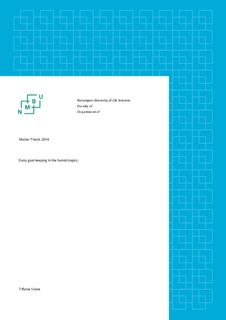| dc.contributor.author | Stone, Tiffanie | |
| dc.date.accessioned | 2014-08-12T10:22:57Z | |
| dc.date.available | 2014-08-12T10:22:57Z | |
| dc.date.copyright | 2014 | |
| dc.date.issued | 2014-08-12 | |
| dc.identifier.uri | http://hdl.handle.net/11250/217053 | |
| dc.description | The aim was to understand animal husbandry practices, benefits and challenges of dairy goat keeping, and to design support that is useful and encourages economic, environmental and socially sustainable integration of dairy goats in Zanzibar. | nb_NO |
| dc.description.abstract | Dairy goats, recently introduced to Zanzibar, play an important role in many small-scale farming systems, improving both income and household nutrition. A survey of 193 dairy goat farmers in Zanzibar was conducted in 2013. The aim was to understand animal husbandry practices, benefits and challenges of dairy goat keeping, and to design support that is useful and encourages economic, environmental and socially sustainable integration of dairy goats in the humid tropics. In 116 questions, the survey addressed topics such as dairy goat feeding, health, milk production, markets and social aspects. Utilizing qualitative and quantitative information increased the scope of the study and enabled a holistic understanding of the farming systems. According to farmers interviewed, key challenges restricting dairy goat keeping in Zanzibar are; disease (57%), drought (49%), lack of funds (21%), low access to health care (18%), and lack of education (14%). Key benefits are income and poverty reduction (35%), manure (33%), milk (18%) and improved household nutrition (15%). A small group (12%) of farmers reported no benefit from keeping dairy goats. Average milk production for a dairy goat in Zanzibar is 0.92 L per day for three months, well below genetic potential. Low milk production was mainly due to poor management, inadequate records and feeding in particular. To help improve management practices, farmers need access to appropriate animal healthcare, milk markets and education on dairy goat husbandry. These findings can inform design of effective extension programmes to help meet farmers’ goals to increase production. | nb_NO |
| dc.description.sponsorship | Enhancing Pro-poor Innovations in Natural Resources and Agricultural Value-chains (EPINAV) | nb_NO |
| dc.language.iso | eng | nb_NO |
| dc.publisher | Norwegian University of Life Sciences, Ås | |
| dc.rights | CC0 1.0 Universal | * |
| dc.rights.uri | http://creativecommons.org/publicdomain/zero/1.0/ | * |
| dc.subject | Sustainable livelihoods | nb_NO |
| dc.subject | Goat diseases | nb_NO |
| dc.subject | Animal nutrition | nb_NO |
| dc.subject | Local marketing | nb_NO |
| dc.subject | Animal health care | nb_NO |
| dc.subject | VDP::Landbruks- og Fiskerifag: 900::Landbruksfag: 910 | nb_NO |
| dc.title | Dairy goat keeping in the humid tropics : a case study of small-scale farming systems in Zanzibar | nb_NO |
| dc.type | Master thesis | nb_NO |
| dc.source.pagenumber | 93 | nb_NO |
| dc.relation.project | Enhancing Pro-poor Innovations in Natural Resources and Agricultural Value-chains (EPINAV) | nb_NO |
| dc.description.localcode | M-AE | nb_NO |

